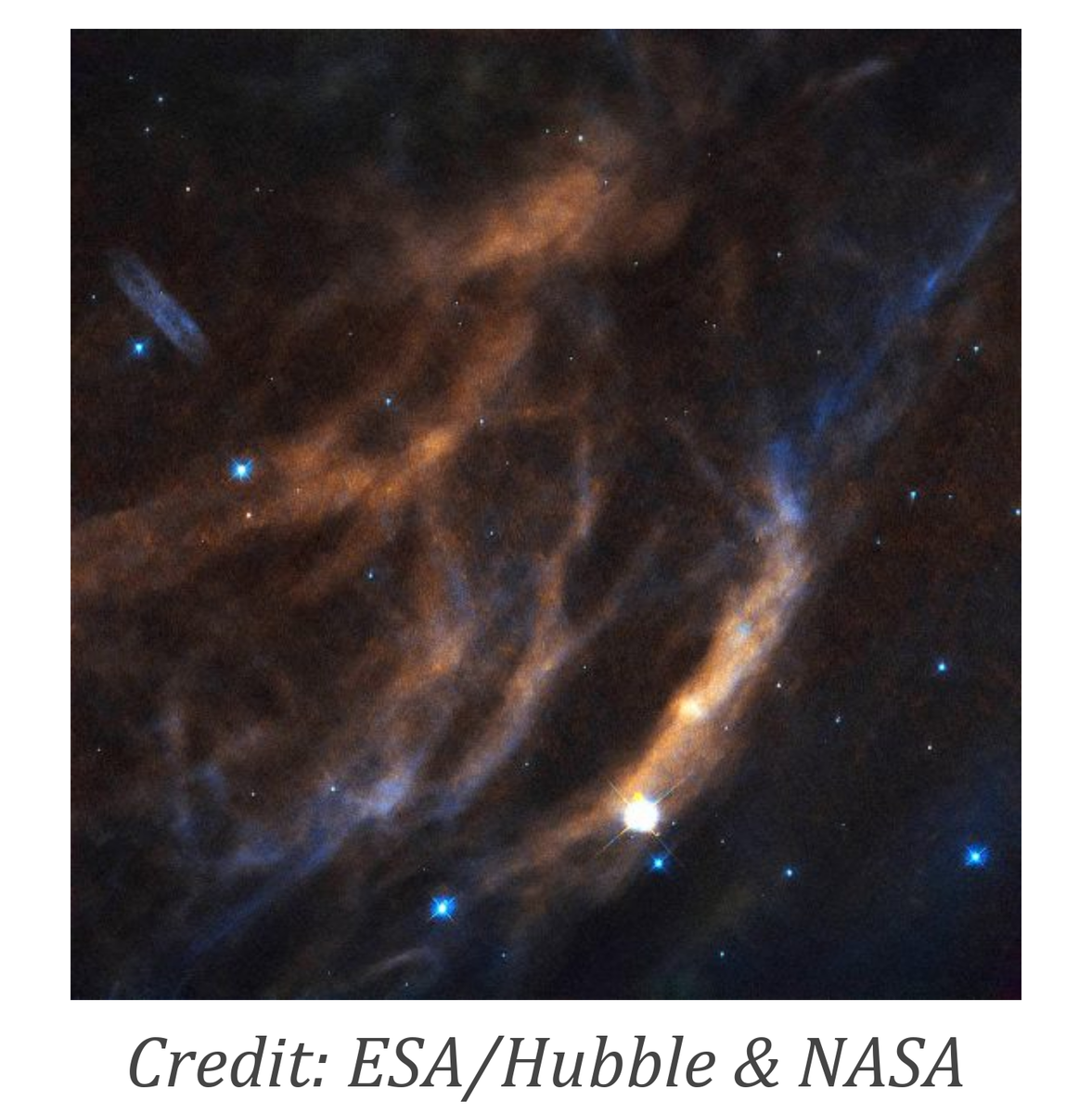[Bubble Layers バブル・レイヤー]
Stephen Smith April 21, 2017Picture of the Day

A portion of bubble nebula Sh2-308.
泡星雲Sh2-308の一部。
―――――――――
Apr 21, 2017
恒星達の周りの球殻は電気的活動の兆候です。
70年以上前にチャールズ・ブルース博士は、惑星状星雲は放電に似ていると述べました。
〈https://www.catastrophism.com/texts/bruce/index.htm〉
彼はそれらの形が砂時計であり、中央の恒星達がほこりっぽいトロイドで覆い隠されていると推論しました。
星雲の形状は、ねじれたフィラメントや放電のらせんに似ているため、それらはまた、ほぼ球形の形状として表示されます。
最近のプレスリリースは、「泡のような構造」がWolf-Rayetの恒星Sh2-308、または星座の主な星座にあるEZの主星座に巻かれていると述べています。
〈https://www.nasa.gov/image-feature/goddard/2017/hubbles-cosmic-bubbles〉
発表が言うには、
「…恒星からの継続的な放射は、泡をどんどん遠くに押し出し、どんどん大きく吹き、膨れています…約60光年離れている!」
プラズマ中の放電は、電流軸に沿ってダブル・レイヤー(二重層)を形成します。
クラウドの一方の側に正の電荷が蓄積し、もう一方の側に負の電荷が蓄積します。
それらの間に強力な電界が発生し、十分な電荷が適用されると、ダブル・レイヤー(二重層)が光ります、それ以外の場合は、「ダーク・モード」のままで表示されません。
プラズマでは、電荷はらせん状にフィラメントになり、それは、お互いを引き付け、時々、アーク・モード放電に「ピンチ」します。
何度も書かれているように、ダブル・レイヤー(二重層)は銀河のバークランド電流からのエネルギーで「ポンプ」することができます。
増加した磁束密度は、周囲の空間からフィラメントに物質を引き込み、星雲の「ガス」を電気的に点火します。
これは欧州宇宙機関によって報告されたものでしょうか?
残念ながら、この時点で、空間内のダブル・レイヤー(二重層)を検出する唯一の方法は、ラングミュアプローブを備えた宇宙船を通過させることです。
〈http://www.fact-index.com/l/la/langmuir_probe.html〉
太陽系内の局所実験は、実験室で作成されたようなダブル・レイヤー(二重層)を検出します。
このような構造は、磁気圏、磁気圏尾、彗星核、彗星尾として知られています。
1981年、ノーベル賞受賞者のハンネスアルフベンは次のように書いています:
「…私たちが直接検出できない構造の存在に基づいて広範囲にわたる結論を下すのは不快です。
〈https://books.google.com/books/about/Cosmic_Plasma.html?hl=ja&id=ZjwoGlIxvLUC〉
しかし、代替案は、仮定から広範囲にわたる結論を導き出す、それは、遠方の地域では、プラズマの特性は私たちの近所にあるものとは大きく異なります。
これは明らかにはるかに不快です...」
フィラメント、ブレード、重なり合ったリング、中心の星の周りの積み重ねられたリング、砂時計の形、およびフィラメントの密着した「チューブ」、それらは、Sh2-308の周りに表示されます。
電気的宇宙では、空間を流れるのは高温ガスではなく、プラズマです。
風の物理学ではなく、電気の物理学が適用されます。
惑星状星雲の殻の内部には、キャパシタ(コンデンサー)のように機能する1つまたは複数のプラズマ・シースがあり、電気エネルギーを交互に蓄積および放出します。
電流は、退潮し、流れます、殻の内側と外側の鞘を。
ハッブル宇宙望遠鏡の画像は、プラズマの基本的なグロー・モード特性の多くを示しています。
中心の恒星の軸はZピンチ・ファンネル(漏斗)であるため、電流の円柱は円または泡のように見えます。
星雲は電気の流れの中で恒星のZピンチであるため、中央の恒星の放射「負荷」を供給するのに十分な電力があります。
恒星達は、他の場所で何度も書かれているように、それらは、核融合ではなく、星雲の放電電流と「結合」した電気によって駆動されます。
星雲電流はそれらの光学グローを超えて存在することはできないので、それらは、天の川を流れる完成した回路の一部でなければなりません。
スティーブン・スミス
―――――――――
Apr 21, 2017
Spherical shells around stars are signs of electrical activity.
恒星達の周りの球殻は電気的活動の兆候です。
More than 70 years ago Dr. Charles Bruce noted that planetary nebulae are similar to electric discharges.
70年以上前にチャールズ・ブルース博士は、惑星状星雲は放電に似ていると述べました。
〈https://www.catastrophism.com/texts/bruce/index.htm〉
He reasoned that their shapes were hourglasses, with central stars obscured by dusty toroids.
彼はそれらの形が砂時計であり、中央の恒星達がほこりっぽいトロイドで覆い隠されていると推論しました。
Since nebular shapes are similar to the twisted filaments and spirals of electric discharges, they also appear as near-spherical shapes.
星雲の形状は、ねじれたフィラメントや放電のらせんに似ているため、それらはまた、ほぼ球形の形状として表示されます。
A recent press release states that a “bubble-like structure” is wrapped around Wolf-Rayet star Sh2-308, or EZ Canis Majoris in the constellation Canis Major.
最近のプレスリリースは、「泡のような構造」がWolf-Rayetの恒星Sh2-308、または星座の主な星座にあるEZの主星座に巻かれていると述べています。
〈https://www.nasa.gov/image-feature/goddard/2017/hubbles-cosmic-bubbles〉
As the announcement says, “…ongoing radiation from the star pushes the bubble out farther and farther, blowing it bigger and bigger…some 60 light-years apart!”
発表が言うには、
「…恒星からの継続的な放射は、泡をどんどん遠くに押し出し、どんどん大きく吹き、膨れています…約60光年離れている!」
Electric discharges in plasma form double layers along their current axes.
プラズマ中の放電は、電流軸に沿ってダブル・レイヤー(二重層)を形成します。
Positive charges build up on one side of the cloud and negative charges on the other.
クラウドの一方の側に正の電荷が蓄積し、もう一方の側に負の電荷が蓄積します。
A powerful electric field develops between them and if enough charge is applied the double layer glows otherwise, it remains in “dark mode” and is invisible.
それらの間に強力な電界が発生し、十分な電荷が適用されると、ダブル・レイヤー(二重層)が光ります、それ以外の場合は、「ダーク・モード」のままで表示されません。
In plasma, the electric charges spiral into filaments, which attract each other, sometimes “pinching” into arc mode discharges.
プラズマでは、電荷はらせん状にフィラメントになり、それは、お互いを引き付け、時々、アーク・モード放電に「ピンチ」します。
As written many times, double layers can be “pumped” with energy from galactic Birkeland currents.
何度も書かれているように、ダブル・レイヤー(二重層)は銀河のバークランド電流からのエネルギーで「ポンプ」することができます。
Increased flux density draws matter from surrounding space into filaments, igniting nebular “gases” electrically.
増加した磁束密度は、周囲の空間からフィラメントに物質を引き込み、星雲の「ガス」を電気的に点火します。
Could this be what is reported by the European Space Agency?
これは欧州宇宙機関によって報告されたものでしょうか?
Unfortunately, at this point in time, the only way to detect double layers in space is to send a spacecraft equipped with a Langmuir probe through them.
残念ながら、この時点で、空間内のダブル・レイヤー(二重層)を検出する唯一の方法は、ラングミュアプローブを備えた宇宙船を通過させることです。
〈http://www.fact-index.com/l/la/langmuir_probe.html〉
Local experiments within the Solar System detect double layers like those created in the laboratory.
太陽系内の局所実験は、実験室で作成されたようなダブル・レイヤー(二重層)を検出します。
Such structures are known as magnetospheres, magnetotails, cometary nuclei, and comet tails.
このような構造は、磁気圏、磁気圏尾、彗星核、彗星尾として知られています。
In 1981, Nobel laureate Hannes Alfvén wrote:
“…it is unpleasant to base far-reaching conclusions on the existence of a structure which we cannot detect directly.
1981年、ノーベル賞受賞者のハンネスアルフベンは次のように書いています:
「…私たちが直接検出できない構造の存在に基づいて広範囲にわたる結論を下すのは不快です。
〈https://books.google.com/books/about/Cosmic_Plasma.html?hl=ja&id=ZjwoGlIxvLUC〉
But the alternative is to draw far-reaching conclusions from the assumption that in distant regions, the plasmas have properties which are drastically different from what they are in our own neighborhood.
しかし、代替案は、仮定から広範囲にわたる結論を導き出す、それは、遠方の地域では、プラズマの特性は私たちの近所にあるものとは大きく異なります。
This is obviously far more unpleasant…”
これは明らかにはるかに不快です...」
Filaments, braids, overlapping rings, stacked rings around the central star, hourglass shapes, and coherent “tubes” of filaments are visible around Sh2-308.
フィラメント、ブレード、重なり合ったリング、中心の星の周りの積み重ねられたリング、砂時計の形、およびフィラメントの密着した「チューブ」、それらは、Sh2-308の周りに表示されます。
In an Electric Universe it is not hot gas that flows through space, it is plasma.
電気的宇宙では、空間を流れるのは高温ガスではなく、プラズマです。
The physics of electricity apply, not the physics of wind.
風の物理学ではなく、電気の物理学が適用されます。
Inside the shells of planetary nebulae are one or more plasma sheaths that act like capacitors, alternately storing and releasing electrical energy.
惑星状星雲の殻の内部には、キャパシタ(コンデンサー)のように機能する1つまたは複数のプラズマ・シースがあり、電気エネルギーを交互に蓄積および放出します。
Electric current ebbs and flows inside and outside sheaths within the shells.
電流は、退潮し、流れます、殻の内側と外側の鞘を。
The Hubble Space Telescope’s image reveals many of plasma’s fundamental glow mode characteristics.
ハッブル宇宙望遠鏡の画像は、プラズマの基本的なグロー・モード特性の多くを示しています。
Since the central star’s axis is a z-pinch funnel, the cylinder of electric current appears to be a circle, or bubble.
中心の恒星の軸はZピンチ・ファンネル(漏斗)であるため、電流の円柱は円または泡のように見えます。
Nebulae are stellar z-pinches in a flow of electricity, so there is enough power to supply the radiation “load” of a central star.
星雲は電気の流れの中で恒星のZピンチであるため、中央の恒星の放射「負荷」を供給するのに十分な電力があります。
Stars, as written many times elsewhere, are powered by electricity “coupled” with nebular discharge currents, rather than nuclear fusion.
恒星達は、他の場所で何度も書かれているように、それらは、核融合ではなく、星雲の放電電流と「結合」した電気によって駆動されます。
Since nebular currents cannot exist beyond their optical glows, they must be part of completed circuits that wind through the Milky Way.
星雲電流はそれらの光学グローを超えて存在することはできないので、それらは、天の川を流れる完成した回路の一部でなければなりません。
Stephen Smith
スティーブン・スミス